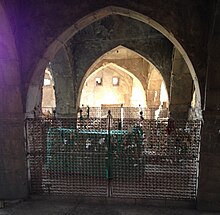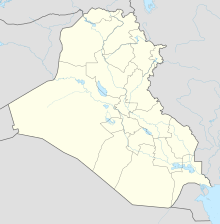User:Kaliforniyka/Alqosh synagogue
| This is not a Wikipedia article: It is an individual user's work-in-progress page, and may be incomplete and/or unreliable. For guidance on developing this draft, see Wikipedia:So you made a userspace draft. Find sources: Google (books · news · scholar · free images · WP refs) · FENS · JSTOR · TWL |
 Claimed tomb of the Prophet Nahum | |
| Location | |
|---|---|
| Coordinates | 32°45′08″N 35°16′52″E / 32.752222°N 35.281111°E |
The Alqosh synagogue is a 13th-century synagogue in Alqosh, Kurdistan. It is one of the few standing synagogues left in Iraq. It is the purported site of the tomb of the Prophet Nahum.
Jewish history
[edit]
Alqosh was also a site of worship for the Hebrew peoples when they were brought by the Assyrian army during the eighth and ninth century BCE. For centuries, Christians and Jews lived together in Alqosh until the Jews were expelled in 1948.
The Alqosh synagogue is one of the few standing synagogues left in Iraq.
Prophet Nahum and Alqosh
[edit]The ancient synagogue in Alqosh reportedly contains the tomb of the prophet Nahum, who correctly prophesied the end of the Assyrian Empire, although Nahum's bones have been relocated to a nearby church. It was common for Iraqi Jews to make a pilgrimage to Alqosh during Shavuot. “He who has not made the pilgrimage to Nahum’s tomb has not yet known real pleasure,” was a common saying.[1]
AalQoun, father of Nahum, was the son of a Hebrew family among thousands whom the Assyrian king Shalmaneser V, who reigned between 727 and 722 BC, brought to Alqosh. These Hebrews lived in peace with the Alqoshniye. The interpretation that seems most logical relies on Marotha, the Alqoshian wise man from three centuries ago who asserted that the name Alqosh is derived from Sîn, the god known as Siin, meaning "the greatest god." It was located at Shweetha D’Gannaweh, a hill north of Alqosh. In this respect, Marotha relays what his ancestors have stated that those living in Nineveh would visit Alqosh every Akitu (the Assyrian and Babylonian New Year) to replay the Enuma Elish which is the Sumerian Epic of Creation. They then would have a religious ceremony in honor of the moon god Sin and the image or icon of the god would be carried in a procession on their way back to Nineveh passing through the old Nineveh Alqosh road.
To its south, an agricultural area known as Bee Siinnat is clearly derived from the word Siin. Forty days later the inhabitants of Nineveh would return the statue or icon of the god to its original place in Alqosh. Based on the foregoing, we believe that the name Alqosh is taken from the Assyrian or earlier Sumerian name for god Siin/Alqosh. Some Sumerologists claim that Inanna, the Sumerian goddess of love and war, was also the offspring of the moon god Sin or as he is was originally known Nanna. Alqoshniye are still awaiting the day when excavations of Shweetha D’Gannaweh, will hopefully reveal new cultural artifacts from its Assyrian or possibly even Pre-Assyrian history. ]
References
[edit]- ^ Neurink, Judit (5 July 2015). "Kurdistan needs help to preserve its Jewish heritage". Jerusalem Post. Retrieved 6 July 2015.


